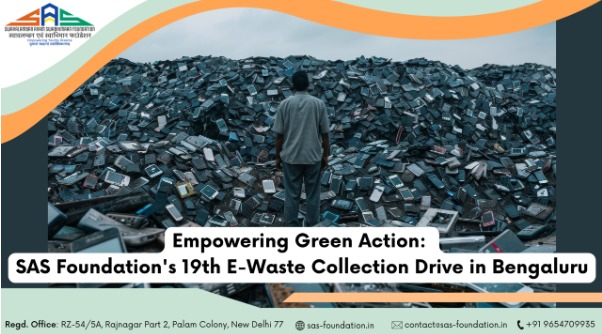🌍 E-Waste Crisis Alert: Challenges, Solutions & the Road to a Sustainable Future
In an age defined by innovation and rapid technological growth, we are producing more gadgets and electronics than ever before. From smartphones and laptops to kitchen appliances and smart devices, our dependency on electronics is undeniable. But what happens when these devices become obsolete or break down?
Welcome to the e-waste crisis — a silent, growing threat to our environment and health. As technology advances, the pile of discarded electronics continues to grow, often unmanaged and untreated. However, amidst the challenges lies an opportunity to build a circular economy that transforms waste into valuable resources and paves the way for a greener tomorrow.
📊 Understanding the E-Waste Crisis
Electronic waste (e-waste) refers to any discarded electronic or electrical equipment — such as phones, computers, televisions, batteries, printers, and more. What makes e-waste particularly dangerous is its composition: it often contains toxic metals like lead, mercury, cadmium, and flame retardants, which can severely pollute air, water, and soil.
🌐 Key Global Statistics:
- The world generated over 53.6 million metric tonnes of e-waste in 2019.
- India is the third-largest producer of e-waste, after China and the USA.
- Only 17.4% of global e-waste is formally recycled.
- Informal recycling sectors expose millions to hazardous chemicals without protection.
As the pace of digital consumption grows, these numbers are expected to skyrocket — making e-waste one of the most urgent environmental issues of our time.
⚠️ Challenges in E-Waste Management
The e-waste crisis is driven by several interlinked challenges:
1. Shorter Lifespan of Devices
Manufacturers are releasing newer models every year, making older devices obsolete sooner. Planned obsolescence has created a culture of “use and discard”, adding to the waste burden.
2. Lack of Consumer Awareness
Most people don’t know how or where to dispose of their e-waste responsibly. Many store it at home or throw it in regular trash, where it ends up in landfills.
3. Informal Recycling Sector
In many developing countries, e-waste is processed by informal workers in unsafe conditions. They often burn cables, crush devices, or use acid baths to extract valuable materials, endangering both themselves and the environment.
4. Weak Infrastructure
Formal recycling systems are limited in number and reach. In India, despite being a top e-waste generator, there are relatively few authorized recycling units accessible to the general public.
5. Low Producer Responsibility
Although Extended Producer Responsibility (EPR) laws exist in many countries, including India, enforcement remains inconsistent. Companies often fail to create proper collection and recycling frameworks.
✅ Sustainable Solutions: Turning Waste into Resources
Despite the magnitude of the problem, the e-waste crisis also offers an opportunity to rethink how we design, use, and discard electronics. Here’s how we can move toward sustainable e-waste management:
1. Promoting Circular Economy Models
A circular economy aims to reuse, refurbish, recycle, and regenerate products rather than dispose of them. It encourages:
- Designing longer-lasting electronics
- Offering repair and upgrade services
- Creating product buy-back or exchange programs
This approach reduces dependency on raw material extraction and minimizes waste.
2. Strengthening E-Waste Collection Drives
Organizations like Swavalamban Avam Swabhimaan Foundation (SAS Foundation) are actively conducting community e-waste drives, encouraging individuals, schools, and businesses to donate their unused electronics.
These initiatives:
- Raise awareness
- Divert waste from landfills
- Ensure responsible recycling through authorized partners
3. Involving Producers and Retailers
Companies must be held accountable through Extended Producer Responsibility (EPR), ensuring they:
- Set up collection points
- Educate customers on e-waste
- Partner with certified recyclers
Some brands are already offering incentives for returning used gadgets — a step in the right direction.
4. Investing in Formal Recycling Infrastructure
India needs more accessible, tech-enabled recycling centers with the capacity to process complex waste. Policies must prioritize funding for:
- State-of-the-art material recovery facilities
- Training programs for informal workers to transition into safe jobs
- Rural outreach centers for e-waste collection
5. Spreading Public Awareness
The most critical piece of the puzzle is education. When people know:
- What qualifies as e-waste
- Why it’s harmful
- How and where to recycle it
…they are more likely to participate in sustainable solutions. Workshops, social media campaigns, school curricula, and street plays can help reach every segment of society.
💡 Role of Innovation and Eco-Friendly Technology
New technologies can also contribute to responsible recycling. For example:
- AI and robotics in sorting facilities improve precision and efficiency
- Chemical-free extraction methods reduce environmental hazards
- Blockchain tracking ensures transparency in the recycling supply chain
Furthermore, eco-design principles can ensure that future gadgets are made with recyclable materials and modular parts, making repairs and upgrades easier.
💚 SAS Foundation’s Commitment to a Greener Future
At Swavalamban Avam Swabhimaan Foundation, we believe that the e-waste crisis is not just an environmental issue — it’s a social justice and public health concern. Our efforts are centered around:
- Conducting door-to-door and community-level e-waste awareness campaigns
- Organizing collection drives in urban and semi-urban areas
- Partnering with authorized recyclers for ethical waste processing
- Educating students and youth to become sustainability ambassadors
In our most recent 16th e-waste drive, we collected over 2296 kg of e-waste, moving closer to our annual goal of 3 tonnes. Every device collected represents not just waste removed — but hope for a cleaner planet.
🌱 The Road Ahead
Combating the e-waste crisis requires collaboration across sectors:
- Citizens must embrace responsible consumption.
- Corporates must innovate and take accountability.
- Governments must enforce laws and invest in infrastructure.
- NGOs must continue to educate and mobilize communities.
By working together, we can transform this crisis into an opportunity — not just to manage waste but to reshape our relationship with technology.
📢 Get Involved Today!
Want to join the movement?
✅ Collect and donate your unused electronics
✅ Spread awareness in your school, office, or neighborhood
✅ Support organizations like SAS Foundation
✅ Ask your favorite brands about their e-waste policies
✅ Subscribe to our newsletter and stay updated!
👉 Subscribe on LinkedIn: https://lnkd.in/gfeaFC2v
Let’s make responsible recycling a habit, not an afterthought.
Let’s build a future where technology empowers without polluting.
Let’s turn waste into wonder. 🌍










